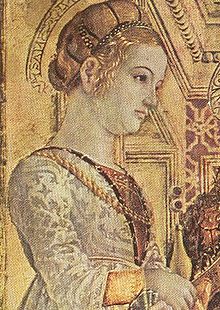Ippolita Maria Sforza
| Ippolita Maria Sforza | |
|---|---|
| Duchess of Calabria | |
 A painting of Ippolita Maria Sforza as Saint Lucy | |
| Born | 18 April 1446 Cremona |
| Died | 20 August 1484 (aged 38) Naples |
| Spouse | Alfonso, Duke of Calabria |
| Issue | Ferdinand II of Naples Isabella of Naples Piero of Rossano, Prince of Rossano |
| House | House of Sforza |
| Father | Francesco I Sforza, Duke of Milan |
| Mother | Bianca Maria Visconti, Duchess of Milan |
| Religion | Roman Catholic |
Ippolita Maria Sforza (18 April 1446 – 20 August 1484), Duchess of Calabria, was a member of the powerful Italian condottieri Sforza family which ruled the Duchy of Milan from 1450 until 1535. She was the first wife of Alfonso, Duke of Calabria, who later reigned as King Alfonso II of Naples.[1]
Family
Ippolita was born in Cremona on 18 April 1446, the eldest daughter of Francesco I Sforza, Duke of Milan (23 July 1401 – 6 March 1466) and Bianca Maria Visconti, Duchess of Milan (31 March 1425 – 28 October 1468). She had six brothers and one younger sister.
Her paternal grandparents were Muzio Attendolo Sforza, a renowned condottiero, and Lucia di Torsano, and her maternal grandparents were Filippo Maria Visconti, Duke of Milan and Agnese del Maino, daughter of Ambrogio del Maino, a Milanese nobleman and ducal questore.
Early life and education
Ippolita was a very intelligent and cultured young woman. She was tutored by the Greek scholar and grammarian Constantine Lascaris, who taught her philosophy and Greek. With her sisters and brothers she was taught in a palace school. When she was 14 years old she made a Latin address to pope Pius II at the diet of Mantua, which became well known after it was circulated in manuscript.[2]
She composed many letters. These have been published in Italy in a single volume entitled, The Letters of Ippolita Maria Sforza, and edited by Serena Castaldo. Previously, in 1893, in Bologna, F. Gabotto published a collection of Ippolita's letters which she had written in Naples from 1475 to 1482.[3]
Apart from epistolary activity, her notable writings include poetry and a Latin eulogy for her father Francesco.[4]
Marriage and issue
On 10 October 1465, in Milan, Ippolita, aged nineteen, married Alfonso, Duke of Calabria (4 November 1448 – 18 December 1495), the eldest son of King Ferdinand I of Naples and Isabella di Chiaramonte, Duchess of Calabria. He would later reign briefly as King Alfonso II of Naples. Ippolita was never crowned Queen consort as her death occurred ten years before Alfonso attained the Neopolitan throne. The marriage of Alfonso and Ippolita was politically advantageous as it created a powerful alliance between the Kingdom of Naples and the Duchy of Milan, which was one of the most important of the 15th century Italian city-states. Ippolita was Alfonso's first wife. Her initially harmonious marriage descended into rivalry and contempt; her husband Alfonso, perhaps threatened by her high level of education or disdainful of her pedigree, treated her with a lack of respect throughout the marriage.
Together, Alfonso and Ippolita had three children:
- King Ferdinand II of Naples (26 August 1469 – October 1496), married Joan of Naples (15 April 1479 – 27 August 1518)
- Isabella of Naples, Duchess of Bari (2 October 1470 – 11 February 1524), married her first cousin Gian Galeazzo Sforza, Duke of Milan, by whom she had issue, including Bona Sforza (13 February 1495 – 7 November 1558) Queen consort of King Sigismund I of Poland, who in her turn had six children.
- Piero of Rossano, Prince of Rossano (31 March 1472 – 17 February 1491), Lieutenant General of Apulia, died of an infection following leg surgery.[5]
Ippolita Maria Sforza died at Naples on 20 August 1484 at the age of thirty-eight. Her husband subsequently married his mistress of long-standing, Truzia Gazzela, by whom he already had two illegitimate children, born during his marriage to Ippolita.
Ippolita Maria Sforza in art

There are many portraits of Ippolita in existence, which depict her in various stages of her life; as a baby, in her girlhood, and throughout her marriage up until her death in 1484. The portraits show her to have been pretty, with fine, chiseled features, a round face, high forehead, long wavy blond hair, and prominent blue eyes.[7] Italian Renaissance artist, Piero della Francesca, sculpted a bust of Ippolita.
Notes
- ^ Charles Cawley, Medieval Lands, Dukes of Milan
- ^ . p. 172.
{{cite book}}: Cite uses deprecated parameter|authors=(help); Missing or empty|title=(help) - ^ Nadia Covini, Princesses and Ladies of Power at the Sforza Court, 2006, retrieved on 3 December 2008
- ^ . p. 172.
{{cite book}}: Cite uses deprecated parameter|authors=(help); Missing or empty|title=(help) - ^ Charles Cawley, Medieval Lands, Sicily/Naples, Counts and Kings
- ^ Maike Vogt-Luerssen
- ^ www.Kleio.org/en/history/famtree/sforza/1050aa.html, by Maike Vogt-Luerssen
References
- Jane Stevenson (2005). Women Latin poets: language, gender, and authority, from antiquity to the Eighteenth Century. Oxford University Press.
